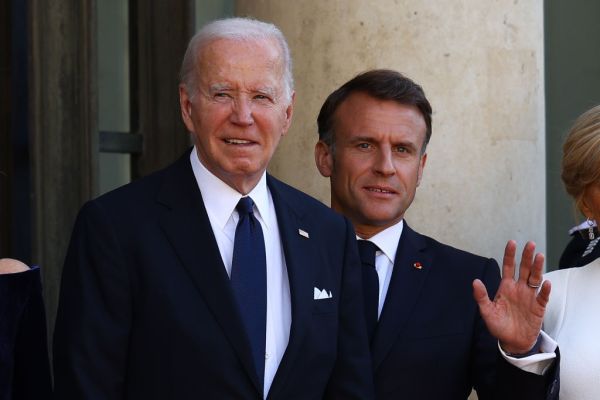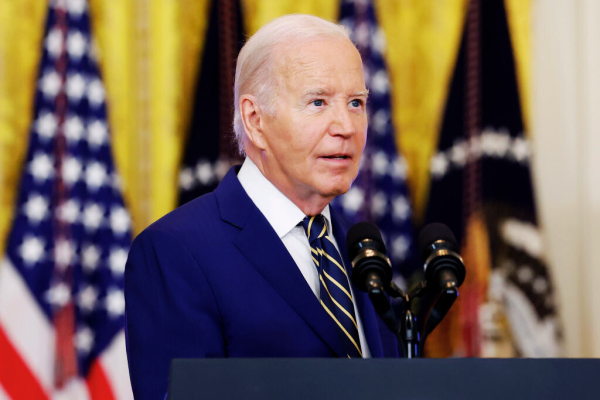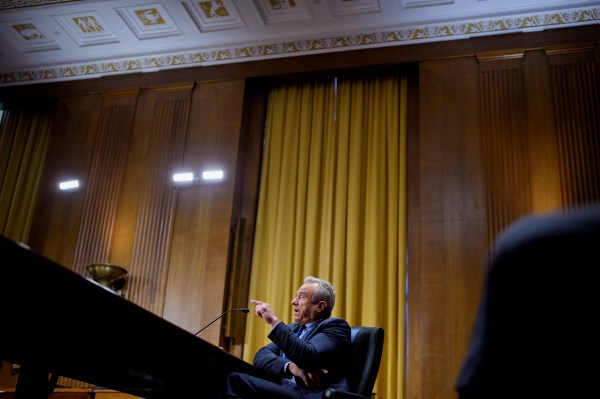To conservative bloggers of a certain age, the phrase “fake but accurate” represents an entire era in media.
Ask ol’ Jonah Goldberg. He’ll tell you. He was there.
The term was used in 2004 to describe a series of forged National Guard memos that appeared shortly before that year’s presidential election purporting to detail George W. Bush’s youthful efforts to avoid service in Vietnam. CBS News obtained and promoted the documents—only to have its scoop fall apart when the fledgling right-wing blogosphere exposed them as products of modern word processing software.
Undeterred, some proponents conceded that the documents might be fake but absurdly insisted that the details they provided about Bush’s draft-dodging were accurate. Overnight, “fake but accurate” became shorthand on the right to describe the lengths to which the mainstream media would go to spin events favorably for liberals. In three words it captured everything conservative activists despised about the “objective” establishment press.
Twenty years later, online right-wing media is so ethically degraded that it can only aspire to a standard as lofty as “fake but accurate.” The term that defines this era is “fake news,” a phrase popularized by Donald Trump to discourage Republican voters from lending credence to journalism that reflects badly on him. It’s the flip side of “fake but accurate” insofar as “fake news” can be, and often is, information that’s true yet comes from a distrusted source. It’s Orwellian in that it asks supporters to treat actual fake news—propaganda—as the truth so long as the outlet supplying it is politically sympathetic.
On Monday White House press secretary Karine Jean-Pierre added a new entry to this grim genre when she used the word “cheapfake” at a media briefing.
“Cheapfake” was her way of describing several videos of Joe Biden that have gone viral recently on right-wing social media. Contrary to “deepfakes,” which are manufactured whole cloth by artificial intelligence, “cheapfakes” are clips of actual news footage of the president that have supposedly been edited deceptively to make it seem like he’s lost track of what’s happening around him.
There was this clip of him “freezing” at a White House event:
And this one of him “wandering off” at the G7 summit:
And this one of him “freezing” again onstage at a fundraiser before being led away by his former boss:
Cheapfakes one and all, the White House has said dismissively of the videos. The clips may not be technically fake, they note, but the image of Biden they depict is certainly not accurate.
It seems to me that “cheapfake” is mostly just a Democratic version of crying “fake news.”
In fairness to the president, the clip above of him “wandering” at the G7 is somewhat misleading. The cropped version uploaded by the New York Post might leave you with the impression that Biden was talking to the empty air before Italian Prime Minister Giorgia Meloni intervened. In reality, he appears to have been talking to a paratrooper out of frame, as other versions of the footage reveal.
But the fact that Meloni and Barack Obama felt obliged to guide him suggests that neither was confident in Biden’s awareness of his surroundings. And the vacant grin he displayed at the White House event as others swayed around him points to something more troubling than an aversion to dancing. A younger Joe Biden surely would have joined in and clapped along, at least, instead of standing stiffly.
They weren’t the only cringey moments he had at those events either:
The British tabloid The Sun quoted “well-placed diplomatic sources” following the G7 as saying Biden was “the worst he has ever been” in terms of his acuity during the event and “embarrassing” at times.
What can the president and his campaign do to effectively “message” a problem like this?
“Nothing!” you might reply, having read the June 5 edition of this newsletter, and you would be correct. But they have to say something. Maintaining an awkward silence while damaging videos of Biden circulate on social media would amount to letting allegations of his decline go unanswered. Americans aren’t going to reelect a leader who himself needs to be physically led by those around him.
His campaign needs a messaging strategy about his age. That strategy is “fake news.”
We got a taste of it a few weeks ago after the Wall Street Journal published a story alleging that the president has had “bad moments” during private meetings with members of Congress. Various Biden allies pushed back on that piece by noting that it relied on Trump-supporting Republicans like Kevin McCarthy and Mike Johnson as sources. The “cheapfake” problem is trickier, though, in that it involves video footage one can judge with one’s own eyes. The information it provides is objectively true.
Luckily for Democrats, the “fake news” playbook is available to discredit the truth by appealing to the viewer’s political hostility to the sources promoting it.
Since Jean-Pierre spokes out against “cheapfakes,” host after host after host at Democratic-aligned MSNBC has voiced their indignation at what they would have their audience believe is a dirty trick pulled by right-wing media. Nor has it gone unnoticed by those hosts that two “cheapfake” purveyors, Fox News and the New York Post, are owned by the bête noire of the American left, Rupert Murdoch. The strategy is obvious: Influential liberals hope to convince voters that any footage of Joe Biden seeming feeble henceforth should be presumed to be deceptive enemy propaganda and dismissed out of hand.
Obvious but clever, I should say, in that there will be many more clips of Biden seeming feeble between now and Election Day. “If you’re explaining, you’re losing,” Ronald Reagan famously said; instead of having to explain each “bad moment” piecemeal as it happens, day after day, Democrats are hoping to nuke the entire topic preemptively by shunting it under the heading of “cheapfakes.”
It’s an amusing approach inasmuch as it’s made a right-wing propaganda outlet like Fox defensive about its coverage at a moment when, for once, it’s telling its viewers the actual truth about Biden.
But it’s also exquisitely Trumpy insofar as it aims to transform discernment of the truth from an intellectual exercise into a political one, from an examination of evidence to a test of partisan loyalty. From now on, if you see a clip of the president seeming less than fully aware of his surroundings, you can safely dispense with any anxiety you might feel about it by disregarding it as a “cheapfake.” To do otherwise would be to “play into Republicans’ hands.”
A few days ago I wrote about how right-wing messaging tactics under Trump have changed from spinning events as they happen to creating entirely new realities and substituting them for political failures. Trump didn’t lose the election in 2020 because he alienated too many college-educated suburbanites; why, he didn’t lose the election at all. Democrats seem to be steering toward that same approach with Biden’s age. It’s not that the president has slowed down considerably in his ninth decade and now regularly has “bad moments;” why, he’s been smeared seriatim by a drumbeat of right-wing “cheapfakes.”
In 2018, Lesley Stahl of CBS News recounted a conversation she had with Trump sometime before the 2016 election. She asked him why he’s forever insulting reporters and howling about “fake news,” to which Trump allegedly replied with the most honest thing he’s ever said. “You know why I do it?” Stahl recalled him saying. “I do it to discredit you all and demean you all so when you write negative stories about me, no one will believe you.”
That’s the Democrats’ “cheapfake” strategy vis-a-vis right-wing media. Simultaneously, they’re conditioning their base to pay no attention to troubling videos of Biden and working the so-called refs in the mainstream media by implying that it’s irresponsible for them to take their cues about the president’s mental sharpness from dishonest Republicans.
Judging from the spate of “fact-check” pieces about the videos that have suddenly appeared this week in major media outlets, I’d say the strategy is working.
The fact that the “fake news” strategy might be Democrats’ best spin with respect to the president’s age doesn’t mean it’ll win them the election, of course.
The polling on Biden’s fitness for office is what it is. And the White House is obviously risking a so-called “Streisand effect” by calling public attention to videos of him appearing feeble. (One would think Barbra Streisand, of all people, would be mindful of that possibility, but no.) If you doubt those clips are helping Republicans on balance, consider how aggressively right-wingers are promoting them on social media even though the first presidential debate is just nine days away.
In theory, by lowering expectations for the president, the right is making it easier for him to over-perform at the debate. But in reality, I suspect, the clips are priming viewers to respond suspiciously if Biden performs well. (And not for the first time.) If they can’t reconcile the cogent Joe Biden they see onstage next week with the “freezing,” “wandering” Joe Biden they’ve seen in so-called “cheapfakes,” why would we assume that they’ll conclude the former rather than the latter is the authentic Biden rather than the product of some sort of chicanery?
That’s all that this partisan bickering over the truth or falsity of the clips is ultimately about: Which Joe should voters believe is the “real” one? The Democrats’ “fake news” strategy takes that question head on.
But it won’t be enough to win. In the end, wherever one lands on the mystery of just how senescent Joe Biden is, it’s a fact that fewer Americans believe he’s mentally and cognitively fit for office than believe Trump is. Democrats need to close that gap and whining about “cheapfakes” won’t suffice to do it.
The only option, as regular readers know, is to go scorched-earth on Trump’s own fitness and hope to fight to a draw on that topic, trusting that Americans forced to choose between two equally unsuitable candidates will grudgingly opt for the one less likely to suspend the Constitution.
For starters, that means attacking Trump aggressively for his criminal conviction in Manhattan, the wise counsel of certain pundits notwithstanding:
Team Joe is allocating $50 million up front to the effort. They can’t convince voters that a man who’ll be 86 by the end of his second term deserves their vote but they might convince them that a man with 34 felonies under his belt deserves it a tiny bit less.
Democrats are also marshaling whatever evidence they can find that Trump himself is having more “bad moments” as he ages. All politicians have verbal flubs, but misremembering the name of the doctor who gave you a cognitive test—and who’s now a prominent congressman—is an unusually cringey one.
Friendly media also will help the Biden campaign seed doubts about Trump’s mental fitness. On Monday, MSNBC hosted author Ramin Setoodeh to share impressions of the former president’s decline gleaned from interviewing him at length:
Like any other 78-year-old, Trump is destined to have “low energy” days, to borrow a phrase. When he does, those too will be reported on and eagerly circulated by Democratic social media outlets:
That CNBC segment bothered Trump enough that he felt compelled to respond to it on Truth Social. His critique? Fake news, of course.
The closer we get to Election Day, the more cutthroat the efforts to spin the candidates’ health will get. Biden supporters have already resorted to circulating deceptively favorable edits of one of the president’s “bad moments” to minimize their awkwardness, in fact. And as the debate over “cheapfakes” raged on Monday, a Trump-friendly source pushed a rumor about Biden wanting to be seated during the upcoming debate that appears to have no basis in fact—yet was picked up by Fox News anyway.
Each time Republicans raise an uproar over a new Biden “bad moment,” it conditions voters to treat the next “bad moment” as more meaningful than they otherwise would have. Democrats are going to try to do the same to Trump. If they succeed in convincing the voters who dislike both candidates that the issue of mental infirmity is a wash, the president probably wins.
Ultimately, though, I wonder if Democratic grousing about “cheapfakes” and insinuations about Trump’s health are less about persuading undecided voters than about rallying the left. On Monday Semafor’s Benjy Sarlin framed the question of attacking Trump over his criminal conviction in terms of morale. Left-wingers would have been hugely disappointed had Biden proved too timid to use Trump’s rap sheet against him, he noted. Even if independent voters end up not responding to those attacks, rank-and-file Democrats will be cheered by seeing the president go on offense. That could help with turnout.
It’s the same with “cheapfakes” and Biden’s age, I think. Democrats have taken a merciless beating about their nominee’s mental health from a Republican Party led by a nearly-as-old coup-plotting sociopath and they resent it. The president’s campaign can’t just sit there and take it under those circumstances, whatever value there might be in avoiding the “Streisand effect.” So they’ve embraced the “fake news” strategy, which in one fell swoop reframes the age issue as a matter of right-wing media villainy and demonstrates a rare bit of vigor in the White House by putting Democrats on offense.
In a presidential race that everyone to the left of Marjorie Taylor Greene is unhappy about, that’s worth something.







Please note that we at The Dispatch hold ourselves, our work, and our commenters to a higher standard than other places on the internet. We welcome comments that foster genuine debate or discussion—including comments critical of us or our work—but responses that include ad hominem attacks on fellow Dispatch members or are intended to stoke fear and anger may be moderated.
With your membership, you only have the ability to comment on The Morning Dispatch articles. Consider upgrading to join the conversation everywhere.